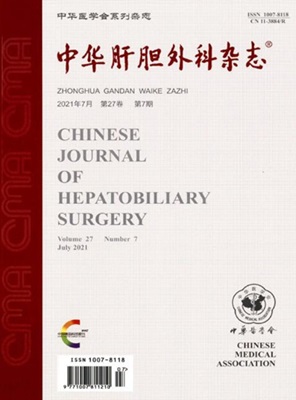肝癌根治性切除后瘤周肝星状细胞与γδ T细胞比值与预后的关系
Q4 Medicine
引用次数: 0
摘要
目的探讨肝癌根治性切除后瘤周肝星状细胞与γδ T细胞比值(SGR)与预后的关系。方法回顾性分析2011年1月至2013年12月在重庆医科大学第一附属医院肝胆外科行根治性肝细胞癌切除术的320例HCC患者的临床资料。免疫组化法计算癌旁组织的SGR。用Kaplan-Meier法估计生存率。采用单因素和多因素分析肝癌患者的预后。结果多因素分析显示,肝癌患者多肿瘤(HR=1.895, 95%CI: 1.155 ~ 3.108)、微血管侵犯(HR=1.665, 95%CI: 1.104 ~ 2.512)、肿瘤大小> ~ 5cm (HR=2.400, 95%CI: 1.603 ~ 3.594)、肿瘤周围SGR> ~ 18 (HR=1.880, 95%CI: 1.256 ~ 2.810)是影响肝癌患者总生存率的独立危险因素。术前AFP >0 μg/L (HR=1.631, 95%CI: 1.151 ~ 2.311)、微血管侵犯(HR=2.145, 95%CI: 1.536 ~ 2.994)、肿瘤大小>5 cm (HR=1.866, 95%CI: 1.342 ~ 2.592)、瘤周SGR>18 (HR=1.517, 95%CI: 1.084 ~ 2.122)是影响HCC患者无瘤生存率的独立危险因素。然后将患者分为低SGR组(比值≤18,n=222)和高SGR组(比值>18,n=98)。低SGR组总生存率和无瘤生存率显著优于高SGR组(P<0.05)。结论肿瘤周围SGR是肝癌根治术后预后的独立因素。低SGR患者预后较好。关键词:肝癌;肝细胞癌;肝星状细胞;γδT淋巴细胞;肿瘤微环境;预后本文章由计算机程序翻译,如有差异,请以英文原文为准。
Prognostic relationship between ratio of peritumoral hepatic stellate cells to γδ T cells and prognosis of patients with hepatocellular carcinoma after curative resection
Objective
To study the association between ratio of peritumoral hepatic stellate cells to γδ T cells ratio (SGR) and prognosis of patients with hepatocellular carcinoma (HCC) after curative resection.
Methods
From January 2011 to December 2013, the clinical data of 320 patients with HCC who underwent curative resection at the Department of Hepatobiliary Surgery, the First Affiliated Hospital of Chongqing Medical University were collected and analyzed retrospectively. Immunohistochemistry was used to calculate the SGR in adjacent cancer tissues. Survival was estimated by Kaplan-Meier method. Prognosis of HCC patients was analyzed by univariate and multivariate analyses.
Results
Multivariate analysis revealed multiple tumors (HR=1.895, 95%CI: 1.155-3.108), microvascular invasion (HR=1.665, 95%CI: 1.104-2.512), tumor size >5 cm (HR=2.400, 95%CI: 1.603-3.594) and peritumoral SGR>18 (HR=1.880, 95%CI: 1.257-2.810) were independent risk factors of the overall survival rate in HCC patients. Preoperative AFP>20 μg/L (HR=1.631, 95%CI: 1.151-2.311), microvascular invasion (HR=2.145, 95%CI: 1.536-2.994), tumor size >5 cm (HR=1.866, 95%CI: 1.342-2.592) and peritumoral SGR>18 (HR=1.517, 95%CI: 1.084-2.122) were independent risk factors of the tumor-free survival rate in HCC patients. Patients were then divided into the low SGR (ratio≤18, n=222) and high SGR groups (ratio>18, n=98) using SGR in adjacent cancer tissues. The overall survival and tumor-free survival rates of the low SGR group were significantly better than the high SGR group (P<0.05).
Conclusion
Peritumoral SGR was an independent prognostic factor of patients with HCC following radical resection. The prognosis of patients with low SGR was better.
Key words:
Carcinoma, hepatocellular; Hepatic stellate cells; γδT lymphocytes; Tumor microenvironment; Prognosis
求助全文
通过发布文献求助,成功后即可免费获取论文全文。
去求助
来源期刊

中华肝胆外科杂志
Medicine-Gastroenterology
CiteScore
0.20
自引率
0.00%
发文量
7101
期刊介绍:
Chinese Journal of Hepatobiliary Surgery is an academic journal organized by the Chinese Medical Association and supervised by the China Association for Science and Technology, founded in 1995. The journal has the following columns: review, hot spotlight, academic thinking, thesis, experimental research, short thesis, case report, synthesis, etc. The journal has been recognized by Beida Journal (Chinese Journal of Humanities and Social Sciences).
Chinese Journal of Hepatobiliary Surgery has been included in famous databases such as Peking University Journal (Chinese Journal of Humanities and Social Sciences), CSCD Source Journals of China Science Citation Database (with Extended Version) and so on, and it is one of the national key academic journals under the supervision of China Association for Science and Technology.
 求助内容:
求助内容: 应助结果提醒方式:
应助结果提醒方式:


